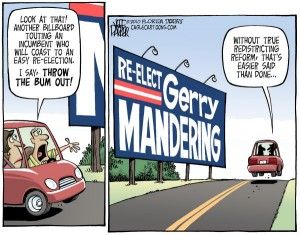11 More Ways to Fix Busted Redistricting
By JOHN HRABE
My list of 10 Ways To Improve the Redistricting Process has elicited a large number of thoughtful responses from experts in the Capitol. One legislative office told CalWatchDog.com that they’re investigating whether any of the reforms can be introduced as legislation this term.
I’ve culled through the feedback and assembled a revised list of recommendations and observations based on the experts, many of whom were directly involved in the redistricting process. The only organization that didn’t send us feedback was the one group we asked: the California Citizens’ Redistricting Commission.
1. Hiring Process: The Commission’s hiring process for staff and consultants should be fully transparent. Full transparency means that applicants’ names and applications should be made public and the public should have an opportunity to comment on the applicants prior to their hiring. The Commission took the position, upon the advice of counsel for the Secretary of State, that employee hiring was a personnel matter that could be conducted without the disclosure of applications in closed sessions. This was inconsistent with the letter and spirit of full transparency set forth in the Voters First Act, Proposition 11, enacted in 2008.
2. Bi- Partisan Staff and Consultants: The Commission’s staff and consultants should be bi-partisan or multi-partisan. With the exception of the Commission’s public relations person, all Commission staff and consultants were ideological liberals or Democrats. Executive Director Daniel Claypool and Staff Attorney Marian M Johnston are liberal Democrats. Karin McDonald, the mapping consultant for Q2, and Ana Henderson are progressives to the left of the Democrats. Moreover, the same can be said of consultants Matt Barreto and Justin Leavitt. Significantly, the Gibson Dunn firm’s ostensible bi-partisanship was undermined by apparent, early and continued exclusion of Dan Kolkey from significant participation. When there is no balance, there is no check. Checks and balances could have averted some of the partisan unhappiness at the end of the process.
3. Advance Publication of Commission Documents Under Bagley-Keene: The Commission should fully comply with Bagley-Keene. Disclosure of action documents at the time they are considered does not comply with the Bagley-Keene Open Meeting Act of 2004, and also led to unnecessary acrimony and public unhappiness.
4. Decision-Making Process: The Commission’s approach to its decision-making process needs to change. The first draft maps weren’t the ones the Commission could have adopted, since they failed to meet the six legal criteria in Prop. 11. The cancellation of the scheduled releases of the second draft maps meant that the public was deprived of a stationary target for its comments, and resulted in the “final” maps being disclosed only at the end of the process when public comment became totally ineffectual. The Commission solicited but did not evaluate outside organizations’ statewide and regional maps. The Commission directed staff only to present one final map of each type, depriving Commissioners of the option to choose among competing, and equally-compliant map alternatives. All of these deficiencies in process affected the opportunity for effective comment.
5. Conflict of Interest Criteria: The Bureau of State Audits’ conflict of interest criteria did not provide full public disclosure of potential conflicts of interest. Among the problems: Gabino Aguirre failed to disclose all his political contributions as well as his organizational affiliation with CAUSE, a group that was a participant in the Commission’s process. Commissioners also failed to update their conflict information (the disclosures were not updated after the initial applications). Were stricter conflict of interest provisions applied to commissioners, Dr. Aguirre and perhaps other commissioners would have been disqualified from participating in some substantive and personnel decisions of the Commission.
6. Out-of-Meeting “Decision Making”: Commissioner Michael Ward has alleged that the commissioners conducted decision making during informal meetings and meals outside the Commission meetings. Whether this allegation was correct or not, there was the opportunity associated with these off-hours activities for such out-of-meeting decision making activities whether or not the motive to make decisions out of meeting was present. While common communications should not be restricted, the Commission needs to adopt reasonable standards and procedures to limit actual or apparent out-of-meeting decision making, and to obtain additional ethics guidance that reflects Bagley-Keene Act limitations applicable to state officials.
7. Ex Parte Communications: The Commission should adopt or improve ex parte communication disclosure rules. Ex parte communications occur in informal situations when Commissioners are meeting or speaking with members of the public or in private meetings.
8. Racial and Ethnic Diversity: The issue of racial and ethnic diversity requirements needs to be addressed and is being litigated in the case, Connerly v. State Board of Audits and Citizens’ Redistricting Commission. The courts will almost certainly resolve whether the statutory requirements comply with Proposition 209 before the 2020 cycle.
9. Population Deviation: Population deviation was one of the most contentious topics for this commission as the Democrats sought to have as much as a 5 percent population deviation while two Republicans sought to have a 1 percent deviation. The commission implemented a 2 percent population deviation standard, double what some legal experts advised. The larger population deviation allows for more freedom to craft districts or engineer them toward a goal. The larger the deviation, the more wiggle room to shift people into neighboring districts. A 1 percent population deviation would create more city splits throughout the state, but would greatly limit how much extra-constitutional engineering can be accomplished.
10. Nesting: The requirement to nest state Senate districts should be moved up in the rank of ordered constitutional criteria as its intent was to prevent the gerrymandering of the Senate maps. Nesting is where two Assembly districts are combined to form a Senate district. Theoretically, all 80 Assembly districts could be nested into the 40 Senate district. But the commission only nested three senate districts. That was miserable failure and complete disregard for this requirement. The requirement to nest was ranked lower than “communities of interest.” That allowed the commission to cut-and-paste together any areas they deemed appropriate, instead of joining neighboring assembly districts.
11. Transcripts: Searchable meeting transcripts must be made available to public within 48 hours of a meeting (not up to 4 months later).
Related Articles
Brown steers clear of Dems as election nears
State Democrats haven’t had much luck in securing the biggest show of support in California — Gov. Jerry Brown. As
Brown’s Tough Talk For Tough Times
JAN. 4, 2011 By KATY GRIMES With many in the state worried that California is ungovernable, even more hope that
Rail Firms Lack Accountability
NOV. 15, 2010 By ANTHONY PIGNATARO The California High-Speed Rail Authority really loves its contractors. It easily employs more than




